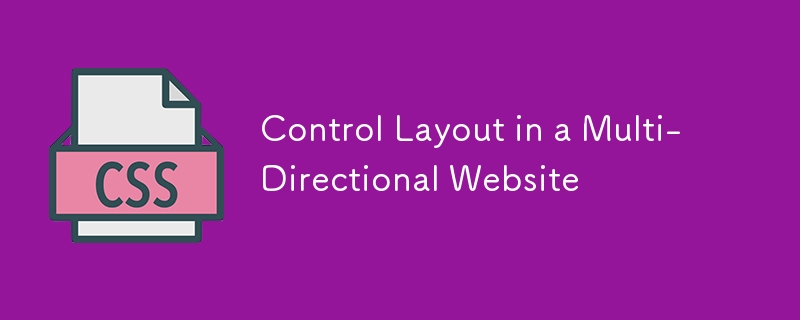Control Layout in a Multi-Directional Website
This article explores efficient CSS techniques for building multi-directional multilingual websites. Creating websites that seamlessly handle both left-to-right (LTR) and right-to-left (RTL) languages is crucial for global reach. While content translation is straightforward, adapting layouts for differing text directions requires careful planning.

The article outlines six key strategies:
1. HTML Markup Foundation: Utilizing the lang and dir attributes in HTML tags is fundamental. lang specifies the language (e.g., en, ar, jp), while dir indicates the direction (ltr or rtl). These attributes are essential for SEO and accessibility. Including a meta charset="utf-8" tag ensures broad character support.
2. CSS Custom Properties: Employing CSS custom properties (variables) simplifies managing style changes across different languages and directions. Instead of hardcoding values, assign them to variables, making updates easier and maintaining consistency. Example: --primary-text-color, --margin-left (better: --margin-inline-start). This is particularly useful for responsive design and features like dark mode.
3. CSS Pseudo-classes and Selectors: Leverage the :lang() pseudo-class to target specific languages for customized styling. The :attr() pseudo-class dynamically uses attribute values within CSS, enabling content adjustments without modifying styles directly. Selecting by the dir attribute ([dir='rtl']) allows for direction-specific styling.
4. Web Font Management: Choose fonts that support both LTR and RTL scripts. Use fallback fonts to ensure readability across languages. Alternatively, use CSS variables and :lang() to dynamically select fonts based on language.
5. CSS Logical Properties: Utilize logical properties like margin-inline-start, padding-block-end, etc., instead of their physical counterparts (margin-left, padding-bottom). These properties automatically adjust based on the writing direction, simplifying RTL support.
6. Advanced Layout Considerations: Addressing layout complexities involves strategic use of:
-
Positioning:
position: absoluteorfixedmight require adjustments for RTL layouts. Consider alternatives if possible. -
transform: translate(): Use CSS variables to manage translation values, inverting them for RTL. -
Margins: Negative margins can affect layout significantly. Understand how they interact with RTL and consider
transform: translate()as an alternative for more predictable behavior. -
Flexbox and Grid: These layout modules offer powerful tools for responsive and direction-aware designs. Utilize
flex-direction,align-items,justify-content,grid-template-columns, andgrid-template-rowsto control element placement in both LTR and RTL contexts.
The article concludes with a comprehensive example demonstrating these techniques, highlighting the importance of a mobile-first approach and the flexibility offered by CSS variables and logical properties for creating maintainable and robust multilingual websites. The use of CSS Grid and Flexbox for responsive layouts is emphasized, showcasing their adaptability to different writing modes.
The above is the detailed content of Control Layout in a Multi-Directional Website. For more information, please follow other related articles on the PHP Chinese website!

Hot AI Tools

Undresser.AI Undress
AI-powered app for creating realistic nude photos

AI Clothes Remover
Online AI tool for removing clothes from photos.

Undress AI Tool
Undress images for free

Clothoff.io
AI clothes remover

Video Face Swap
Swap faces in any video effortlessly with our completely free AI face swap tool!

Hot Article

Hot Tools

Notepad++7.3.1
Easy-to-use and free code editor

SublimeText3 Chinese version
Chinese version, very easy to use

Zend Studio 13.0.1
Powerful PHP integrated development environment

Dreamweaver CS6
Visual web development tools

SublimeText3 Mac version
God-level code editing software (SublimeText3)

Hot Topics
 1662
1662
 14
14
 1419
1419
 52
52
 1311
1311
 25
25
 1261
1261
 29
29
 1234
1234
 24
24
 Google Fonts Variable Fonts
Apr 09, 2025 am 10:42 AM
Google Fonts Variable Fonts
Apr 09, 2025 am 10:42 AM
I see Google Fonts rolled out a new design (Tweet). Compared to the last big redesign, this feels much more iterative. I can barely tell the difference
 How to Create an Animated Countdown Timer With HTML, CSS and JavaScript
Apr 11, 2025 am 11:29 AM
How to Create an Animated Countdown Timer With HTML, CSS and JavaScript
Apr 11, 2025 am 11:29 AM
Have you ever needed a countdown timer on a project? For something like that, it might be natural to reach for a plugin, but it’s actually a lot more
 HTML Data Attributes Guide
Apr 11, 2025 am 11:50 AM
HTML Data Attributes Guide
Apr 11, 2025 am 11:50 AM
Everything you ever wanted to know about data attributes in HTML, CSS, and JavaScript.
 A Proof of Concept for Making Sass Faster
Apr 16, 2025 am 10:38 AM
A Proof of Concept for Making Sass Faster
Apr 16, 2025 am 10:38 AM
At the start of a new project, Sass compilation happens in the blink of an eye. This feels great, especially when it’s paired with Browsersync, which reloads
 How We Created a Static Site That Generates Tartan Patterns in SVG
Apr 09, 2025 am 11:29 AM
How We Created a Static Site That Generates Tartan Patterns in SVG
Apr 09, 2025 am 11:29 AM
Tartan is a patterned cloth that’s typically associated with Scotland, particularly their fashionable kilts. On tartanify.com, we gathered over 5,000 tartan
 How to Build Vue Components in a WordPress Theme
Apr 11, 2025 am 11:03 AM
How to Build Vue Components in a WordPress Theme
Apr 11, 2025 am 11:03 AM
The inline-template directive allows us to build rich Vue components as a progressive enhancement over existing WordPress markup.
 PHP is A-OK for Templating
Apr 11, 2025 am 11:04 AM
PHP is A-OK for Templating
Apr 11, 2025 am 11:04 AM
PHP templating often gets a bad rap for facilitating subpar code — but that doesn't have to be the case. Let’s look at how PHP projects can enforce a basic
 Programming Sass to Create Accessible Color Combinations
Apr 09, 2025 am 11:30 AM
Programming Sass to Create Accessible Color Combinations
Apr 09, 2025 am 11:30 AM
We are always looking to make the web more accessible. Color contrast is just math, so Sass can help cover edge cases that designers might have missed.




